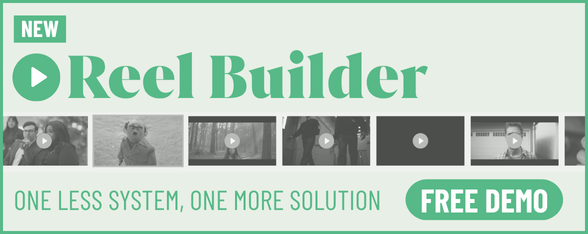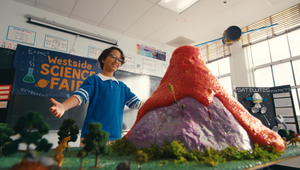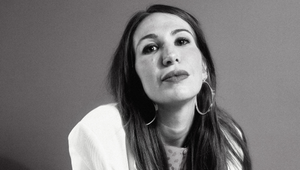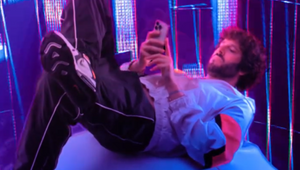
The Directors: Matvey Fiks

Matvey Fiks is a director based in New York. He graduated from NYC’s School of Visual Arts with BFA in film (directing) in 2016. With the support of Kodak’s 2015 Scholarship Award, Matvey shot his thesis film Douggy that held its international premiere at Locarno International Film Festival and followed with numerous festival screenings around the world, including New York Film Festival and Moscow International Film Festival. Matvey has been directing music videos, commercials projects and campaigns for brands such as Gucci, Versace, Genesis, Zara, Under Armour, Instagram among others. Matvey is a recipient of The Webby People’s Voice Award (2018) for his documentary about photographer Odds and Ends. His music video Sky Breaking Clouds Falling for Mason Lindahl received Silver at Young Director Award (2021).
LBB> What elements of a script sets one apart from the other and what sort of scripts get you excited to shoot them?
Matvey> In the commercial realm, my main criteria is finding a challenge in a script, be it creative or execution-oriented. It's all about discovering a task that I can dive into, almost convincing myself it's as groundbreaking as a mission to Mars. This mindset not only fuels my motivation but also sparks inspiration for my team, fostering collective progression.
While some scripts are inherently ambitious, technical, and come with a hefty budget—where the challenge is evident and the director's guidance is crucial—others demand a different kind of creativity to define the mission. Picture a 15-second spot set in a modern, well-lit interior with two actors on a couch, each holding a product. The challenge here lies in making your professional presence meaningful, while of course aligned with the brand's needs. If one can also translate the director's style, this becomes a true mark of excellence.
I'm particularly drawn to scripts that call for inventive solutions, whether the need for this solution is apparent on the surface, or requires a bit of excavation. These are the projects that keep my creative journey engaging and rewarding.
LBB> How do you approach creating a treatment for a spot?
Matvey> When presented with scripts that carry an understated message, where the directive is, "here is our BIG idea - please tell us how to make it work," I find it particularly rewarding and straightforward. In these instances, I roll up my sleeves, diving into extensive visual research, closely consulting with head departments, and collaborating with my producer to craft a true-to-life solution. This involves not only textual propositions but also test-shoots, previsualization, and storyboarding to provide a comprehensive visual representation.
When faced with highly detailed scripts, my primary goal is to discern the agency's expectations—which elements are non-negotiable and which are open to creative exploration, what got me short-listed, and the scale of the changes I, as the director, am authorised to propose. And when clarity is achieved - that’s when I roll my sleeves. It's a delicate dance, ensuring my proposals strike the right balance between my cinematic desires and meeting the agency's needs.
Regardless whether the expectations are clear, I always aim to outline (sometimes shape) an emotional stake and a story progression. Be it a technical or mood-driven script, a 15-second or 90-second duration, whether it’s visually rich, dynamic, and full of entertaining tricks, if it lacks an emotional stake and universally relatable motif (even if it’s between the lines), it can fall short. Outlining that storyline arch is the key and should be the basis for any type of work in any genre.
LBB> If the script is for a brand that you're not familiar with/ don’t have a big affinity with or a market you're new to, how important is it for you to do research and understand that strategic and contextual side of the ad? If it’s important to you, how do you do it?
Matvey> It's incredibly important. Commercial directing is undoubtedly a creative discipline, but it's not an exercise in the creative stream of consciousness—it's not an auteur form. I firmly believe that every creative decision made during production should be motivated by the brand's background, ideology, campaign goals, and the audience it aims to reach.
Understanding what you're shooting, for whom, how it's used, and its history is crucial. When working on projects with brands that are new to me, I make a concerted effort to immerse myself in every available detail. I especially lean towards the agency for input, given their inherent role in being familiar with the brand's nuances.
This thorough understanding ensures that my creative choices are not only aesthetically sound but also strategically aligned with the brand's identity and objectives.
LBB> For you, what is the most important working relationship for a director to have with another person in making an ad? And why?
Matvey> Certainly, an accurately assembled team comprising the cinematographer, production designer, editor, stylist, sound designer, and other head departments directly influences the end result of any project. Yet, in my view, two roles can play a decisive role in shaping a director's work on a commercial: the creative director and the line producer.
The collaboration between the director and the agency's creative director/lead, when built on trust and respect, has the potential to elevate a project to another level, pushing creative boundaries and ensuring a smoother shoot. This relationship is my top priority—I strive to sync with their vision, fully understand expectations, and then lay out suggestions and solutions in a way that is registered and heard.
Reflecting on my latest project for Adidas, working with Johannes Leonardo's creative director, Alfonso Ruiz, for the first time, turned into one of my most remarkable collaborations with an agency. With a shared desire to achieve the best, a humble one-day shoot in NY, non-union shoot, became a collective mission to stretch resources and creative scale to the maximum. As a result, we exceeded expectations - all due to mutual drive and dedication to the creative.
Equally crucial is the relationship with the line-producer—the individual who controls all the tools and processes needed to bring the promises made in the treatment to life. Being a good line-producer is not just about skill; it's a communicational and coordinational talent. When experiences align, understanding each other becomes second nature, processes flow seamlessly, and decisions are well-communicated and preserved.
The dynamics between these two roles are mutually dependent and require delicate handling for the sake of achieving exceptional work.
LBB> What type of work are you most passionate about - is there a particular genre or subject matter or style you are most drawn to?
Matvey> I'm most passionate about work that defies labels and encompasses a diverse range of genres, styles, and subject matters. While some directors get pigeonholed into specific categories like car commercials, comedy, or sports, I find inspiration in those who manage to build a career as versatile storytellers. It's a challenging feat since directors are often short-listed based on their proven expertise in a particular domain.
I initially started with fashion and lifestyle films, and was commonly considered a director in that niche. Eventually, I set out to prove that I could handle technical challenges as well. Whether it's motion control-centric projects, Phantom's frozen time concepts, or Russian arm car jobs, I wanted to showcase my adaptability. Now, I find the most excitement in projects that demand a fusion of both—where my technical skills meet the aesthetic of lifestyle storytelling.
LBB> What are your thoughts on opening up the production world to a more diverse pool of talent? Are you open to mentoring and apprenticeships on set?
Matvey> Every culture, ethnicity, and age brings its unique codes, and the richness of diversity translates into authentic, genuine, and original work—criteria that I hold in highest regard.
The director's career ladder is undeniably one of the trickiest to climb in the industry. The stories of how people end up in the director's chair vary widely, and unfortunately, there isn't a specific formula. I've noticed that DPs often start as an AC or gaffer, and editors make their way up from assisting. For these disciplines, aspiring professionals can learn the craft by assisting a seasoned pro on a specific project—a relatively short-term commitment in the commercial world. However, the director's role involves coordinating various departments over a much longer timeframe, spanning development, pre-production, and post-production, often in different parts of the world.
Given my experiences, I feel a responsibility to give back the opportunities I was fortunate to receive. I make a conscious effort to invite, respond, and suggest to those seeking experience or advice. I've had individuals shadow me on set, observe the editing process, and even just watch the set being run from the video village during shoots. It's my way of contributing to a more inclusive and accessible path for aspiring talents in the industry.
LBB> What’s your relationship with new technology and, if at all, how do you incorporate future-facing tech into your work (e.g. virtual production, interactive storytelling, AI/data-driven visuals etc)?
Matvey> My journey in filmmaking began with a deep appreciation for classical tools and conventional methods—embracing documentary approaches, motion picture usage, traditional dramaturgy, practical tricks, and real locations. However, as I progress further, I find myself increasingly drawn to new technology.
I firmly believe that a director needs to be technically advanced, understanding the nuances of film stocks, video codecs, software capabilities, camera resolutions, lighting equipment, and more. This knowledge isn't about micromanaging the departments underneath, but rather leveraging it to develop ideas and optimise the shooting process. Many of my creative impulses begin with technical hypotheses—I might ponder a specific technical phenomenon and think, "Hmm, no one has ever done a whole music video using this—could be kind of cool!"
My hands-on film school education equipped me with various technical skills. Upon graduation, I engaged in every aspect of the production world, from serving as a production assistant to film-loading and editing. It wasn't just proximity to the big processes that benefited me; it was understanding these technical niches that continues to keep me on top of things.
Regarding new technology, I consistently expand my knowledge. I fool around in Blender to build 3D worlds, explore different image/video generators, and delve into AI to grasp its further potential. Not to become a professional in these specific niches, but to understand their capabilities, stay abreast of contemporary offerings, and speak the language of professionals collaborating on the same project. While my style and aesthetic preferences remain filmic, realistic, and practical, the evolving tools I use make my work more accessible, and concepts faster and cheaper to produce. Whether it's brainstorming with a cinematographer and production designer while experimenting with different camera focal lengths in the 3D space of Sketch-Up or reflecting on planned blocking and light transitions in Unreal Engine for the sake of having a previsualization to foresee issues that might arise on the shoot day.
LBB> Which pieces of work do you feel really show off what you do best – and why?
Matvey>
My most recent project—what a joy to create for a brand you genuinely admire, feel, and wear. This script had an intuitive concept rooted in the name of the product - Rivalry. Picture a series of competing buddies, respectfully bantering on screen, while nurturing each other to push further, each in their own portion of the split screens. I proposed exploring and progressing this concept in front of the audience's eyes, suggesting a live transition from a single screen to the split one in a continuous shot when the banter kicks off. It's a great example of a healthy collaboration between the agency and the director. "Here's our idea—let's kick it up a notch."
Daniel Arnold | Odds & Ends
This one's close to my heart. A passion project, self-funded, shot on 16mm short ends, fully improvised—basically, we just went for it with zero expectations. Then, bam! Vogue picked it up, and it gained some serious exposure. Teamwork with Mika Alstkan, my closest buddy and collaborator, not only defined a style we've stuck with on many projects but also kick-started our careers in the commercial scene.
Car commercials, right in the middle of my work's sweet spot—blending lifestyle aesthetics with technical expertise. Breaking into the car scene was a challenge, but thanks to CZAR Netherlands and Innocean Korea with the world campaign for the Genesis I made in 2022. This one is my second car job, and I have to admit, shooting car commercials is probably the most entertaining process ever: breathtaking locations, all the cool technical toys, and precision driving. It's like being in a movie of its own.
Scalapay | Take your time to enjoy
Here's another one where aesthetics meets technicality in a big way. This is the kind of project where the "mission to Mars" is glaringly obvious—you're trying to bring something to life that you can hardly find references for. Imagine hours of chats with the motion control operator, CG supervisor, DP, and AD. Calculations, pre-shoots, previsualizations, around 7 plates for each setup, and a solid three months in post.















